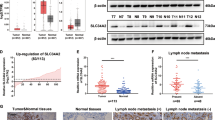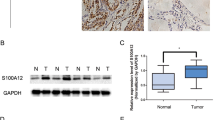Abstract
Purpose
StAR Related Lipid Transfer Domain Containing 13 (STARD13) serves as a tumor suppressor and has been characterized in several types of malignancies. However, the role and the molecular mechanism of STARD13 in regulating the progression of papillary thyroid carcinoma (PTC) remain underexplored.
Methods
The gene expression and clinical information of thyroid cancer were downloaded using “TCGAbiolinks” R package. Quantitative PCR and immunohistochemical staining were conducted to detect the expression of STARD13 in clinical tumor and adjacent non-tumor samples. Wound-healing assay, Transwell assay and 3D spheroid invasion assay were performed to evaluate the migratory and invasive capacities of PTC cells. Cell proliferation ability was determined by CCK-8 assay, colony formation assay and 5-ethynyl-2’-deoxyuridine (EdU) incorporation assay. The alterations of indicated proteins were detected by Western blotting.
Results
In the present study, we found that STARD13 was significantly underexpressed in PTC, which was correlated with poor prognosis. Downregulation of STARD13 might be due to methylation of promoter region. Loss-and gain-of-function experiments demonstrated that STARD13 impeded migratory and invasive capacities of PTC cells in vitro and in vivo. In addition, we found that STARD13 regulated the morphology of PTC cells and inhibited epithelial-mesenchymal transition (EMT).
Conclusion
Our results suggest that STARD13 acts as a metastasis suppressor and might be a potential therapeutic target in PTC.







Similar content being viewed by others
Data availability
All GSE datasets analyzed during the current study are available in the GEO repository, http://www.ncbi.nlm.nih.gov/gds. The RNA sequencing data of TCGA-THCA dataset can be obtained from TCGA, https://cancergenome.nih.gov/. The clinical information of TCGA-THCA dataset and DNA methylation data are accessible at UCSC Xena browser, https://xena.browser.net/.
References
H. Sung, J. Ferlay, R.L. Siegel, M. Laversanne, I. Soerjomataram, A. Jemal et al. Global cancer statistics 2020: GLOBOCAN estimates of incidence and mortality worldwide for 36 cancers in 185 countries. CA Cancer J. Clin. 71(3), 209–249 (2021)
F. Basolo, E. Macerola, A.M. Poma, L. Torregrossa, The 5(th) edition of WHO classification of tumors of endocrine organs: changes in the diagnosis of follicular-derived thyroid carcinoma. Endocrine 80(3), 470–476 (2023)
T. Yan, W. Qiu, J. Song, Y. Fan, Z. Yang, ARHGAP36 regulates proliferation and migration in papillary thyroid carcinoma cells. J. Mol. Endocrinol. 66(1), 1–10 (2021)
L. Torregrossa, D. Viola, E. Sensi, M. Giordano, Piaggi, C. Romei et al. Papillary thyroid carcinoma with rare exon 15 BRAF mutation has indolent behavior: a single-institution experience. J. Clin. Endocrinol. Metab. 101(11), 4413–4420 (2016)
H. Guan, Y. Guo, L. Liu, R. Ye, W. Liang, H. Li et al. INAVA promotes aggressiveness of papillary thyroid cancer by upregulating MMP9 expression. Cell Biosci. 8, 26 (2018)
S. El-Sitt, B.D. Khalil, S. Hanna, M. El-Sabban, N. Fakhreddine, M. El-Sibai, DLC2/StarD13 plays a role of a tumor suppressor in astrocytoma. Oncol. Rep. 28(2), 511–8 (2012)
Y. Ching, C.M. Wong, S.F. Chan, T.H. Leung, D.C. Ng, D.Y. Jin et al. Deleted in liver cancer (DLC) 2 encodes a RhoGAP protein with growth suppressor function and is underexpressed in hepatocellular carcinoma. J. Biol. Chem. 278(12), 10824–30 (2003)
V. Ullmannova, N.C. Popescu, Expression profile of the tumor suppressor genes DLC-1 and DLC-2 in solid tumors. Int. J. Oncol. 29(5), 1127–32 (2006)
T.H. Leung, Y. Ching, J.W. Yam, C.M. Wong, T.O. Yau, D.Y. Jin et al. Deleted in liver cancer 2 (DLC2) suppresses cell transformation by means of inhibition of RhoA activity. Proc. Natl Acad. Sci. USA 102(42), 15207–12 (2005)
T.H. Leung, J.W. Yam, L.K. Chan, Y.P. Ching, I.O. Ng, Deleted in liver cancer 2 suppresses cell growth via the regulation of the Raf-1-ERK1/2-p70S6K signalling pathway. Liver Int. 30(9), 1315–23 (2010)
F. Gao, X. Yu, R. Meng, J. Wang, L. Jia, STARD13 is positively correlated with good prognosis and enhances 5-FU sensitivity via suppressing cancer stemness in hepatocellular carcinoma cells. Onco Targets Ther. 11, 5371–5381 (2018)
F. Tang, R. Zhang, Y. He, M. Zou, L. Guo, T. Xi, MicroRNA-125b induces metastasis by targeting STARD13 in MCF-7 and MDA-MB-231 breast cancer cells. PLoS One 7(5), e35435 (2012)
S. Chang, S. He, G. Qiu, J. Lu, J. Wang, J. Liu et al. MicroRNA-125b promotes invasion and metastasis of gastric cancer by targeting STARD13 and NEU1. Tumour Biol. 37(9), 12141–12151 (2016)
M. Wu, X. Tan, P. Liu, Y. Yang, Y. Huang, X. Liu et al. Role of exosomal microRNA-125b-5p in conferring the metastatic phenotype among pancreatic cancer cells with different potential of metastasis. Life Sci. 255, 117857 (2020)
Y. Lu, W. Zheng, X. Rao, Y. Du, J. Xue, MicroRNA-9-5p facilitates lung adenocarcinoma cell malignant progression via targeting STARD13. Biochem. Genet. 60(6), 1865–1880 (2022)
L. Chen, W. Hu, G. Li, Y. Guo, Z. Wan, J. Yu, Inhibition of miR-9-5p suppresses prostate cancer progress by targeting StarD13. Cell Mol. Biol. Lett. 24, 20 (2019)
X. Xu, S. Zheng, MiR-887-3p negatively regulates STARD13 and promotes pancreatic cancer progression. Cancer Manag. Res. 12, 6137–6147 (2020)
Y. Qian, Y. Zhang, H. Ji, Y. Shen, L. Zheng, S. Cheng et al. LINC01089 suppresses lung adenocarcinoma cell proliferation and migration via miR-301b-3p/STARD13 axis. BMC Pulm. Med. 21(1), 242 (2021)
J. Cai, J. Zhao, N. Zhang, X. Xu, R. Li, Y. Yi et al. MicroRNA-542-3p suppresses tumor cell invasion via targeting AKT pathway in human astrocytoma. J. Biol. Chem. 290(41), 24678–88 (2015)
W. Liang, H. Guan, X. He, W. Ke, L. Xu, L. Liu et al. Down-regulation of SOSTDC1 promotes thyroid cancer cell proliferation via regulating cyclin A2 and cyclin E2. Oncotarget 6(31), 31780–91 (2015)
A. Subramanian, P. Tamayo, V.K. Mootha, S. Mukherjee, B.L. Ebert, M.A. Gillette et al. Gene set enrichment analysis: a knowledge-based approach for interpreting genome-wide expression profiles. Proc. Natl Acad. Sci. USA 102(43), 15545–50 (2005)
W. He, Y. Sun, J. Ge, X. Wang, B. Lin, S. Yu et al. STRA6 regulates tumor immune microenvironment and is a prognostic marker in BRAF-mutant papillary thyroid carcinoma. Front Endocrinol. (Lausanne) 14, 1076640 (2023)
N. Cancer Genome Atlas Research, Integrated genomic characterization of papillary thyroid carcinoma. Cell 159(3), 676–90 (2014)
M. Xing, A.S. Alzahrani, K.A. Carson, Y.K. Shong, T.Y. Kim, D. Viola et al. Association between BRAF V600E mutation and recurrence of papillary thyroid cancer. J. Clin. Oncol. 33(1), 42–50 (2015)
W. Pu, X. Shi, P. Yu, M. Zhang, Z. Liu, L. Tan et al. Single-cell transcriptomic analysis of the tumor ecosystems underlying initiation and progression of papillary thyroid carcinoma. Nat. Commun. 12(1), 6058 (2021)
H. Tang, L. Jiang, C. Zhu, R. Liu, Y. Wu, Q. Yan et al. Loss of cell adhesion molecule L1 like promotes tumor growth and metastasis in esophageal squamous cell carcinoma. Oncogene 38(17), 3119–3133 (2019)
Z. Miao, Q. Cao, R. Liao, X. Chen, X. Li, L. Bai et al. Elevated transcription and glycosylation of B3GNT5 promotes breast cancer aggressiveness. J. Exp. Clin. Cancer Res. 41(1), 169 (2022)
D.S. Chandrashekar, S.K. Karthikeyan, P.K. Korla, H. Patel, A.R. Shovon, M. Athar et al. UALCAN: an update to the integrated cancer data analysis platform. Neoplasia 25, 18–27 (2022)
L. Jaafar, I. Fakhoury, S. Saab, L. El-Hajjar, W. Abou-Kheir, M. El-Sibai, StarD13 differentially regulates migration and invasion in prostate cancer cells. Hum. Cell 34(2), 607–623 (2021)
L. Sun, J. Sun, J.D. Song, High expression of DLC family proteins predicts better prognosis and inhibits tumor progression in NSCLC. Mol. Med. Rep. 19(6), 4881–4889 (2019)
S. Hanna, B. Khalil, A. Nasrallah, B.A. Saykali, R. Sobh, S. Nasser et al. StarD13 is a tumor suppressor in breast cancer that regulates cell motility and invasion. Int J. Oncol. 44(5), 1499–511 (2014)
A. Nasrallah, B. Saykali, S. Al Dimassi, N. Khoury, S. Hanna, M. El-Sibai, Effect of StarD13 on colorectal cancer proliferation, motility and invasion. Oncol. Rep. 31(1), 505–15 (2014)
Z. Huang, Z. Zhang, C. Zhou, L. Liu, C. Huang, Epithelial-mesenchymal transition: the history, regulatory mechanism, and cancer therapeutic opportunities. MedComm (2020). 3(2), e144 (2022)
L. Jaafar, Z. Chamseddine, M. El-Sibai, StarD13: a potential star target for tumor therapeutics. Hum. Cell 33(3), 437–443 (2020)
M. Al Haddad, R. El-Rif, S. Hanna, L. Jaafar, R. Dennaoui, S. Abdellatef et al. Differential regulation of rho GTPases during lung adenocarcinoma migration and invasion reveals a novel role of the tumor suppressor StarD13 in invadopodia regulation. Cell Commun. Signal 18(1), 144 (2020)
Z. Yang, H. Chen, M. Shu, Y. Zhang, L. Xue, Y. Lin, DLC2 operates as a tumor suppressor gene in breast cancer via the RhoGTPase pathway. Oncol. Lett. 17(2), 2107–2116 (2019)
A.C. Braun, M.A. Olayioye, Rho regulation: DLC proteins in space and time. Cell Signal 27(8), 1643–51 (2015)
D. Bar-Sagi, A. Hall, Ras and Rho GTPases: a family reunion. Cell 103(2), 227–38 (2000)
E. Sahai, C.J. Marshall, RHO-GTPases and cancer. Nat. Rev. Cancer 2(2), 133–42 (2002)
J. Chen, C. Jiang, L. Fu, C.L. Zhu, Y.Q. Xiang, L.X. Jiang et al. CHL1 suppresses tumor growth and metastasis in nasopharyngeal carcinoma by repressing PI3K/AKT signaling pathway via interaction with Integrin beta1 and Merlin. Int J. Biol. Sci. 15(9), 1802–1815 (2019)
B.D. Khalil, S. Hanna, B.A. Saykali, S. El-Sitt, A. Nasrallah, D. Marston et al. The regulation of RhoA at focal adhesions by StarD13 is important for astrocytoma cell motility. Exp. Cell Res. 321(2), 109–22 (2014)
S. Abdellatef, I. Fakhoury, M.A. Haddad, L. Jaafar, H. Maalouf, S. Hanna et al. StarD13 negatively regulates invadopodia formation and invasion in high-grade serous (HGS) ovarian adenocarcinoma cells by inhibiting Cdc42. Eur. J. Cell Biol. 101(1), 151197 (2022)
M.A. Nieto, R.Y. Huang, R.A. Jackson, J.P. Thiery, Emt: 2016. Cell 166(1), 21–45 (2016)
X. Li, L. Zheng, F. Zhang, J. Hu, J. Chou, Y. Liu et al. STARD13-correlated ceRNA network inhibits EMT and metastasis of breast cancer. Oncotarget 7(17), 23197–211 (2016)
J. Hu, X. Li, X. Guo, Q. Guo, C. Xiang, Z. Zhang et al. The CCR2 3’UTR functions as a competing endogenous RNA to inhibit breast cancer metastasis. J. Cell Sci. 130(19), 3399–3413 (2017)
L. Zheng, C. Xiang, X. Li, Q. Guo, L. Gao, H. Ni et al. STARD13-correlated ceRNA network-directed inhibition on YAP/TAZ activity suppresses stemness of breast cancer via co-regulating Hippo and Rho-GTPase/F-actin signaling. J. Hematol. Oncol. 11(1), 72 (2018)
Funding
The funding for this project was provided by the National Natural Science Foundation of China (No. 82073050); Guangdong Basic and Applied Basic Research Foundation (No. 2019A1515012046); Guangzhou Technology Project (No. 202102080311).
Author information
Authors and Affiliations
Contributions
G.H.Y., L.Y.B. & X.H.P. conceived, designed and supervised the research and revised the manuscript. Z.C.M. & C.J.X. performed the experiments. Z.C.M., L.H. & L.W.W. analyzed the data. Z.C.M. wrote the manuscript. Z.Y.L. took part in the animal experiments. Z.H.R. collected clinical samples. All authors read and approved the final manuscript.
Corresponding authors
Ethics declarations
Conflict of interest
The authors declare no competing interests.
Ethics approval and consent to participate
The experimental protocols of our study were performed in accordance with the Helsinki Declaration and its later amendments and approved by the Institutional Research Ethics Committee of the First Affiliated Hospital of Sun Yat-sen University. All patients have signed written informed consent. The animal experiments in this study were approved by the Institutional Animal Care and Use Committee of Sun Yat-sen University.
Additional information
Publisher’s note Springer Nature remains neutral with regard to jurisdictional claims in published maps and institutional affiliations.
Supplementary information
Rights and permissions
Springer Nature or its licensor (e.g. a society or other partner) holds exclusive rights to this article under a publishing agreement with the author(s) or other rightsholder(s); author self-archiving of the accepted manuscript version of this article is solely governed by the terms of such publishing agreement and applicable law.
About this article
Cite this article
Zeng, C., Li, H., Liang, W. et al. Loss of STARD13 contributes to aggressive phenotype transformation and poor prognosis in papillary thyroid carcinoma. Endocrine 83, 127–141 (2024). https://doi.org/10.1007/s12020-023-03468-7
Received:
Accepted:
Published:
Issue Date:
DOI: https://doi.org/10.1007/s12020-023-03468-7




